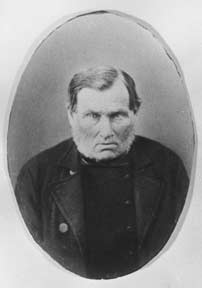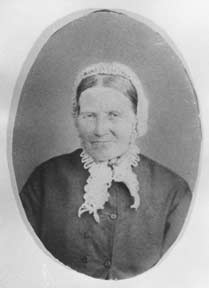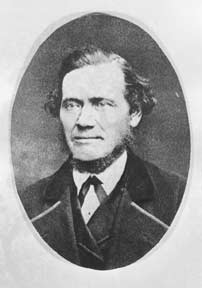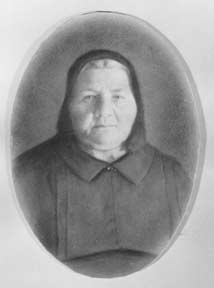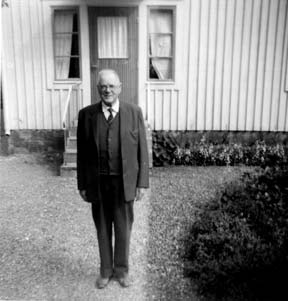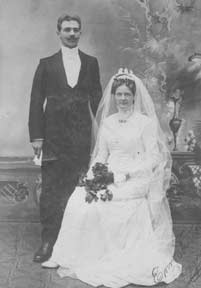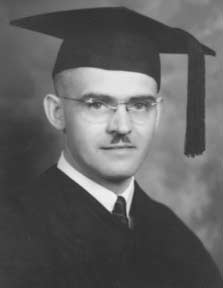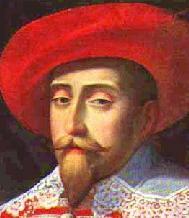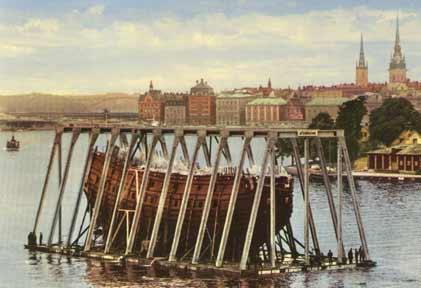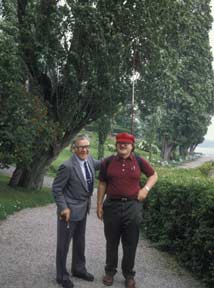|
Gustav Lofgren (R.G.) Smith
(Jan. 6 or June 1, 1870-Nov. 26 or 28, 1951) =
Wilhelmina Josephina (Minnie) Smith (July 31, 1871-Apr.
18, 1965) in 1894
Children:
Wallace Paul Victor Smith (May
2, 1895-May 17 or 21, 1963) = Mildred Vestlund (?-Sept.
18, 1927) on Aug. 24, 1927
Wallace Paul Victor Smith
(1895-1963) = Evelyn Butler(?-?)
Patricia
May Smith (1941-) = Vincent Carter (1938-) in 1962
Kirk Wallace Carter (1963-)
Kraig Vincent Carter (1963-)
Patricia
May Smith (1941-) = Glenn Johnson (1949-) in 1973
Jayme Johnson (1976-)
Lucia
Alexis Smith (1949-) = Stephen Gainer (?-) in 1980
Jarred Gainer (1989-)
[Wallace was a professor of history at Fresno State
University, and wrote several books on the history of
the San Joaquin Valley. His first wife, Mildred,
contracted polio on their honeymoon and died only 3
weeks after their marriage.]
Raymond Theodor Smith (Apr.
12, 1897-Dec. 6, 1980) = Edith Swenson (Jan. 31, 1904-?)
in 1930
No
children.
[Ray worked for the telephone company, and visited
Minnesota several times. He even took home movies and
had a wire recorder we could speak into!]
Mildred Pauline Smith (Mar.
14, 1900-1989) = Halfre Bohleen (1894-1983) in 1929
Gladys Ruth
Bohleen (May 14, 1932-) = Robert Rose (1931-) in 1963
Coleen Rose (1958-) (from Robert's previous
marriage)
Rhiannon (1978-)
Douglas Rose (1964-)
Alice Vilhelmina Smith (Nov.
15, 1901-1999)
Ethel Emilia Smith (Mar. 9,
1903-1995) = David Stanley Kent (1903-1940) in 1936
Jon Stanley
Kent (Apr. 3, 1940-) = Patricia Ann McCarroll (1942-) in
1962
Robert David Kent (1963-)
Michael Edward Kent
(1975-)
R.G. also worked with C.A. on the Wyoming spur line.
Here is a professional photograph of C.A., R.G., and
Fred, along with Mr. Westlund, on a handcar.
ON THE WYOMING (MINNESOTA)
SPUR LINE, 1880s
FRONT ROW (L-R): MR. WESTLUND(?), C.A. LOFGREN.
BACK ROW: R.G. & FRED LOFGREN
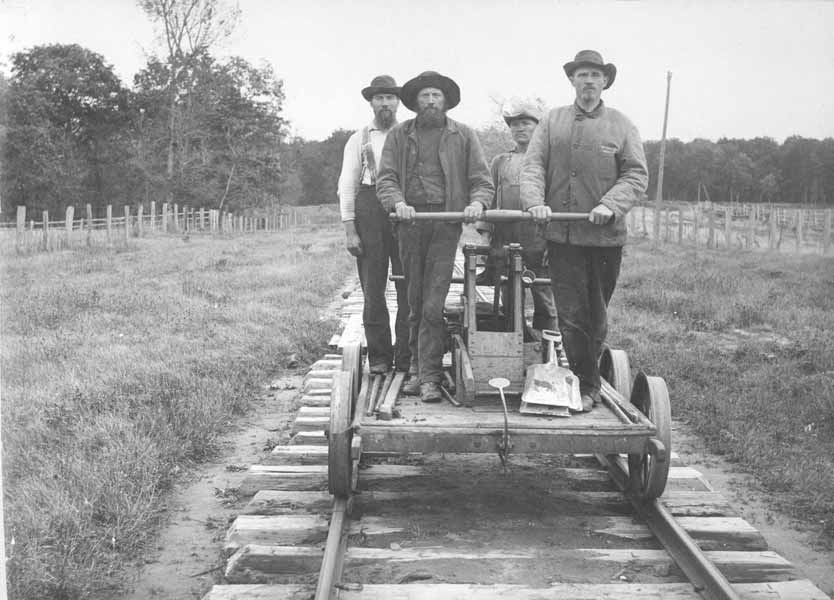 |
Minnie Smith was the daughter of a
pioneer Swedish immigrant, John Anderson (1825-1888),
who was born in Sörby, Linköping, Sweden, came
to America in 1851, and cleared 160 acres on a peninsula
on what is now North Center Lake of the Chisago Lakes.
When he applied for citizenship in 1852, he changed his
name to John Smith, because it sounded more exotic than
Anderson. Minnie was worried that the name would die
out, so, when they married, she convinced R.G. to change
his name to R.G. Smith. Ironically, the daughter who
stayed on the farm, Anna Smith, later married P.J.
Anderson, who evidently didn't go for the
take-your-wife's-name idea, so the land reverted to
Anderson land. (I learned this quite by accident from
Mark Anderson, a descendent of Anna Smith Anderson, who
I met at a party given by mutual friends). After
marriage, R.G. continued to work on the railroad for 12
years. They then moved to Kingsburg, California (1906),
where they began growing grapes for raisins.
In 2007, Gladys Bohleen Rose and her husband, Bob,
visited us in Minnesota. She added some information to
the above account. There was considerable friction
between R.G. and C.A. Lofgren. (Arvid Lofgren told of an
example: when straightening rails, C.A., as section
boss, decided when the rail was straight. R.G. would
then sight down the rails to decide for himself if C.A.
was right.) They all lived in the section house, with
C.A.'s wife Augusta cooking for the crew. Augusta would
open all mail addressed to Lofgren, no matter if it was
addressed to C.A. or R.G. According to Gladys, that was
the main reason for R.G. changing his name to Smith. So
it wasn't to honor Minnie Smith after all. And here I've
always thought, "at least there was one romantic in the
family."
In addition to the friction with C.A., R.G. didn't like
the cold wather in Minnesota, so when a former pastor at
the Lindstrom church wrote back to say how wonderful it
was in California, R.G. and Minnie decided to head for
the promised land. They arrived in San Francisco only a
week or two after the big earthquake, so they headed for
Kingsburg, which already was a thriving Scandinavian
community (even today, the water tower has been modified
to look like a Swedish coffee pot).
In response to the first edition of this history, Jon
Kent of Santa Barbara, California sent the following
information about his relationship with R.G.:
My dad died in 1940, just 6 weeks before I was born,
so mom moved back to the farm in Kingsburg, where I
grew up with my grandparents, R.G. and Minnie, and my
aunt Alice. Wallace also lived there for a time so we
had a house full of teachers. I recall driving the
team of horses, then later tractors. I still have the
hand pump that we used for drinking water. Uncle Ray
taught me so much and I followed in his footsteps in
driving school buses and tour buses for the National
Parks while in college. I have all of his old movies
you mentioned. Pat and I met while students at San
Jose State University. She was born in Juliaca, Peru,
where her dad was a mining engineer. Both parents were
from North Dakota, but her mom was born in Nova
Scotia, and may be a distant relative of mine! (well,
we are all related somehow, aren't we!). My father's
side of the family came to Nova Scotia from Scotland
and I have quite a family history of those wild
folks--they were all peasants too!
R.G. SMITH & FAMILY, 1919
(?)
BACK ROW (L-R): ETHEL, WALLACE, RAY, ALICE
FRONT ROW: R.G., MILDRED, MINNIE
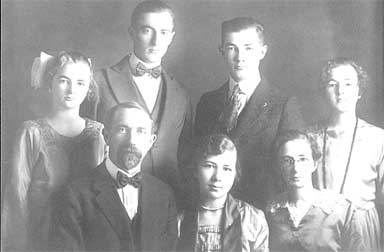 |
In 1951, R.G. was burning trash in his yard when his
clothes caught fire, and he died from the burns. Five
years later, Wallace wrote this detailed letter to
Esther Lofgren Alvin, describing the agony of his death:
December 12, 1956
Dear Esther:
I feel like writing a few words to you tonight. I
think about your mother and my father and the other
persons who have passed out of our lives. You lost a
husband a long time ago, and I buried my first wife. I
often wonder what life is all about.
During the hurly-burly of our father's death I was
so busy that I do not now know whether we sent a copy
of the article about him which appeared in the Fresno
Bee or not. I do remember that I sent an article to
the Chisago County Press together with a request to
Mr. Fred Feske of Lindstrom, a son-in-law of Eddie
Andrews, and a great friend of my Dad, both Feske
& Andrews, that he see that the article be
printed. It was not! Just a short notice! I resented
this, but Norelius, the editor, told Feske, that my
Dad had been away from Lindstrom and Center City so
long that no one would remember him.
Is not life strange. My Dad had coffee with my
Mother, Ethel, and Jon at 10:30. Alice was sick with
the influenza, and was in bed upstairs. It was a
Saturday. Dad then said I am going out to burn some
rubbish, a pile about the size of a small package, not
more than an ordinary person could have carried away
in his two hands. He had bought a new pair of pants
and did not want to get them soiled, so he put on an
old home-made apron which he had made of gunny-sacks.
These sacks had been secured when he had ordered twine
which is used to tie up the canes on the Thompson
Seedless vines. In order to prevent the twine from
rotting, these sacks are treated with an inflammable
emulsion, the kind that does not flame up, but which
burns stubbornly and will not go out easily. It was
blowing slightly that day and as he turned the flames
from the small fire caught hold of his apron without
his knowing it and slowly burned up toward his waist
from the rear. When he felt the heat, he hurriedly
tried to untie the rope which he used to keep his
apron in place, and perhaps due to nervousness, or
because he had tied it too tightly he could not
unloosen it. He had no knife to cut it with and the
fire kept getting hotter, so he cried for help. He
could not roll on the ground to put out the fire, as
the ground was hard, and would not help much, and so
he ran toward the tank-house where Ethel was washing
clothes. Ethel had taken a course in first-aid, and
knew what to do. She put wet wash down in front to
prevent the fire reaching his genital organs, and over
his face. These portions of his anatomy were saved.
But she told me that the wet wash seemed unable to put
out the fire forthwith on his trousers, which burned
away entirely as did his underwear. He was not burned
above the waist, but everything below his belt,
excepting his genitals, appeared to me to look like
raw beef-steak. Oil seemed to exude from all portions
of his lower anatomy when I helped the nurse, Mrs.
Arthur Davidson, change his bandages one morning about
2 A.M. I often went down at night, and stayed until
the wee, small hours of the morning--I had to teach at
Fresno during the day—but kept going down to Kingsburg
at night. I was rather fatigued when it was all
over--he lived for 12 days after the accident--but I
did what I could. A young Army doctor, recently
discharged from the Service, and just then located at
Kingsburg, had the case at the Kingsburg hospital. One
of my neighbors here at Fresno is a retired doctor, a
specialist, and he went with me to see my Dad. He
talked to the young doctor and assured me that he knew
what he was doing, had had much experience with burned
men in the war, and hence no one could do more than he
was doing. So I could then tell my Mother that all was
being done to save Dad. This made her feel better.
My Dad had said, when he went out after 10:30, that
Mother and Ethel should come out at 11 o'clock, and
they would see how nicely he had cleaned up things.
They came out sooner than that, but not with the
original hopes and promises. When my Mother heard the
commotion, she ran out and turned the hose on. It
never fails, the hose was not attached to the facet,
and by the time she had time to hook it in place,
Ethel had killed the fire with the wet wash. It had
all been a matter of seconds. How easy it is to say
that if I had been there with a knife to cut the belt
that held up his apron, or if the hose had been handy
to squirt water on the fire and apron, if-if-if-if-if
he had not tried to burn the rubbish, but had carried
it into the field, et cetera. Life is like that. I try
to cheer my Mother by telling her that his days were
numbered. Had he not lost his life in the fire, he
would soon have passed away due to hardening of his
arteries, the doctor said so, or he might have had an
accident. He still drove his car, and he drove it too
fast--supposing he had had an accident, and had
inadvertently killed someone? The way it was, he died
honorably, and all were sorry to hear about it.
One thing makes me happy, and I am sure you will
appreciate this. He had always been religious, and I
wondered how his religion would hold when he was hurt,
in agony, and no doubt realizing that it was all over.
The Army doctor is a young man of a religious
background, a Mennonite, somewhat like the old-time
Quakers, and he told me he had never met a patient who
was more cheerful under pain. When I went to see my
Dad he kidded me the first time; he said: "Wallie, the
trouble with me is that I don't know how to wear
skirts." He also made a wonderful impression on the
nurses--young and old. One of the older nurses told
him one morning: "You will soon be home, and then you
can celebrate Christmas with your family." He
answered: "You are all so nice to me, and I appreciate
it, but I know better." He never let on to any of
us—his family—but he apparently knew the end was near.
I talked to him about 3 o'clock one morning--Mrs.
Davidson was there--and I patted his shoulder and I
said: "I hope you will get well." He looked at me but
said nothing. Then I added: "I have always admired
you, and been proud of you, and whatever happens, I
want you to know that." He said very calmly: "Well, I
always thought you did." There were no tears, or silly
weeping. We talked man to man, and I told my Mother
about it afterwards. She felt good about it, but sorry
that she had had no last words with him. She was
always taken to see him during the day, when he was
dopey with drugs--I went there during the night when
the drugs had worn off, and he was about to get his
new dosage, so I saw him when he was at his best
mentally.
Had he shown fear of death, anger, or crankiness, I
would have grieved over it, but all concerned, nurses
and they were all, with the exception of one nurse,
good church members and Christians. The one nurse, a
pretty girl, who had no faith, told me that if
religion does that to a man I want to investigate it.
"He dies the way I wish I could, when my time comes!"
One night he asked the elderly nurse on duty—a good
Baptist—to sing Trygarre kan ingen vara, än
Gud's lilla barna skara—and he tried hard to
follow her. He could not sing, as you know, but she
was visibly affected by it all. I do not spell Swedish
well, so no doubt I misspelled some of the foregoing
words.
Paul Lofgren, our cousin, came down to see Dad, and
the latter looked happy when he saw him; it was in the
PM and Dad was somewhat dopey from drugs, but he
called Paul by name, and told me afterwards: "Did you
know Paul is here; he is upstairs." There was no
upstairs, but he did know Paul had come.
According to the mortician and the flower shops, it
was the largest funeral in Kingsburg's history. It was
raining hard--really pouring--and so the crowd which
could not get into the mortuary really must have liked
him to stay out in the rain. Ethel's fellow teachers
from Fowler were there en masse; my fellow professors
from Fresno sent flowers; the words spoken by the two
clergymen were so unusual that one lady from
Fresno--her husband is a State official and she was at
one time a high school teacher--said she had never
heard anything like the beautiful tributes paid him.
The memories are sweet; he lived his religion and
when he was hurt unto death he never once whimpered.
When he was unconscious he moaned terribly, but the
doctor said this was due to internal agony which he
did not allow to show when conscious. I think often of
him when the holidays come, as he was buried on
December 1st.
One thing I resented. I had talked my Mother into
accepting the inevitable, when the nurses at the
hospital, no doubt meaning well, began to tell her Dad
would soon be home. We had Thanksgiving dinner at
Raymond's and Mother had just come from the hospital.
She said: "The nurses tell me Pa will be home for
Christmas." Then everybody began to talk in that
manner, and I finally burst out: "Will you please stop
tormenting a poor wife and mother? I have had her in a
frame of mind where she was willing to accept the
inevitable, and now you are working up false hopes. It
is cruel." I went down to the hospital later, and told
the nurses to cut it out. They did.
"It is appointed unto all men once to die." This I
know! I have seen friends and relatives die. I was not
present when my Dad died. The old Baptist nurse
maintains she suddenly heard the rustling of wings,
and then a soft sigh, and my Dad was dead. I do not
know about such, things. Perhaps there was such a
rustling; perhaps she imagined it; but she did testify
that no man could have talked more sweetly,
confidently, or eagerly about his faith in God and the
Hereafter than did my Dad when he was unconscious and
truly revealing himself.
Death is not the worst that can come to us. One
night I went to see a friend--I am glad he was not
around--I would have frightened him--and I cried as
hard as a little child who has stubbed his toe--from 2
until 4 o'clock in the morning--I then went home--and
have not done so since. No death was then imminent. I
buried a wife, a Dad, other friends--and I have shed
no tears at those times--one can control oneself--so I
don't think I am a baby, but sometimes the struggle
get tough, and for once I lost my self-control. No
doubt you have had those moments. Come and see us some
time. I would like to visit you-all. I love you very
much--Esther, Elmer, Paul--but who knows? Forgive this
long-winded epistolary effusion.
Wallie
|
